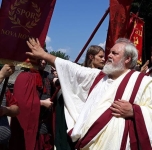Priests (Nova Roma)
Home | Latíné | Deutsch | Español | Français | Italiano | Magyar | Português | Română | Русский | English
⚜⚜⚜ Site Index - Key Pages ⚜⚜⚜
The public rites of the Religio Romana were performed and controlled by a number of different priestly collegia and other special priests and magistrates. Those priestly organizations that ranked below the collegia were known as sodalicia, and there were many "independent" priests of various cults who bore the title sacerdos. In addition, there were a number of priesthoods of well-established "foreign" cults (such as the cult of Isis and Serapis). For a list of current Foreign Priesthoods of these "foreign cults" within Nova Roma, see Foreign priesthoods in Nova Roma. Some of these cults were initiatory, and were called "Mysteries" (such as the Mysteries of Mithras). Nova Roma has reinstated these ancient Priesthoods as part of our effort to reconstruct Roman religion and culture.
Nova Roma is accepting applications for various Priesthoods. If you are interested in helping to rebuild the Religio Romana and the worship of the ancient Roman deities on an official public basis, we would be pleased to hear from you. The Priesthoods in Nova Roma are open to both men and women, with the exception of the Vestals. As Priesthood is an important position of responsibility we do ask that you read the guidelines for applications before applying. Any questions about Priesthood should be directed to the Collegium Pontificum.
If you would like to become a Priest or Priestess of Nova Roma, please submit an Application.
Collegium Pontificum
The Collegium Pontificum (College of Pontiffs) is the supreme body for matters relating to the sacra publica of Nova Roma. It consists of nine pontifices who serve the public rites of the State religion and have general authority to determine the structure and nature of both the public rites and the priesthoods themselves. Voting members are the twelve flamines, six virgines Vestales and the rex sacrorum. They act as the general oversight committee for the public rites of the religio Romana and appoint members of the various priesthoods. Some specific administrative duties of the Collegium include: advising the Senate on religious matters, setting the dates of religious festivals, organizing and assisting the Priesthood, and acting as the final arbiters of Sacred Law and religious disputes. It may be called to order by any pontifex, and all the above listed members of the Collegium are able to vote.
Office of the Pontiffs
For administrative inquiries (priesthood applications, ritus requests, etc.) contact the Pontifices.
Current Membership in the Collegium Pontificum
The current members of the Collegium Pontificum are:
Rex sacrorum
The rex and regina sacrorum (King and Queen of the Sacred) are a legally married couple that perform various public rites and make announcements of festival days. First among the Priests and members of the collegium pontificum, but subordinate to the pontifex maximus. The rex and regina sacrorum may hold no political posts.
Pontifices
Pontifices, along with the other members of the Collegium Pontificum oversee most of sacra publica conducted on behalf of Nova Roma and its People. The title pontifex comes from the Latin for "bridge builder", a possible allusion to a very early role in placating the Gods and spirits associated with the Tiber river, and in building a spiritual bridge between men and the Gods. They are responsible for advising magistrates and private citizens on the performance of public and private rites.
The Pontifex Maximus acts as the Speaker for the Collegium Pontificum, oversees the Comitia Curiata and ritual responsibilities along with the Vestal Virgins.
(5 positions filled, 10 available (5 plebeian, 5 patrician))

|
Gaius Petronius Dexter
Pontifex Maximus |

|
Quintus Fabius Maximus
Pontifex |

|
Quintus Caecilius Metellus Pius Postumianus
Pontifex |

|
Gnaeus Cornelius Lentulus
Pontifex |

|
Marcus Claudius Marcellus
Pontifex |

|
Gaius Petronius Stephanus Turpilianus
Pontifex |
Flamines
The flamines are thirteen high priests who serve specific deities - though they are allowed to worship other deities as well. The sources tell us that a flamen was a sacerdos proper, and who was dedicated to the service of a particular deity. A number of sources fix the number of flamines at fifteen (three maiores and twelve minores), however the names of only thirteen of these are known with certainty. The flamines hold public rites on the days sacred to their deity, and oversee the general worship of that deity. The flamines are present in the Collegium Pontificum.
Flamines Maiores
Flamen Dialis
Position not open at this time. The Flamen Dialis serves the cult of Jupiter, and participates in the Vinalia festivals and at conferratio marriage ceremonies. This priesthood is subject to a large number of complex taboos which have not yet been resolved for reconstruction. The wife of the Flamen Dialis was known as the Flaminica Dialis, and assisted in the rites and was subject to the same taboos.
| POSITION NOT OPEN
|
Flamen Martialis
The Flamen Martialis oversees the cult of Mars, the God of War, leading public rites on the days sacred to Mars.
| POSITION OPEN
|
Flamen Quirinalis
The Flamen Quirinalis oversees the cult of Quirinus, a god related to the peaceful aspect of Mars, who presides over organized Roman social life. The Flamen Quirinalis leads public rites on the days sacred to Quirinus.
| POSITION OPEN
|
Flamines Minores
Flamen Carmentalis
The Flamen Carmentalis oversees the cult of Carmenta (Carmentis), a goddess of Prophecy and Oracles. The Flamen Carmentalis leads public rites on the days sacred to Carmenta.

|
Marca Hortensia Maior Fabiana Faustina
Flamen Carmentalis |
Flamen Cerealis
The Flamen Cerealis oversees the cult of Ceres, Goddess of grains (identified with the Greek Demeter). The Flamen Cerealis leads public rites on the days sacred to Ceres.
| POSITION OPEN
|
Flamen Falacer
The Flamen Falacer oversees the cult of the God Falacer.
| POSITION OPEN
|
Flamen Floralis
The Flamen Floralis oversees the cult of Flora, the Goddess of flowers, and Spring (and therefore new beginnings). The Flamen Floralis leads public rites on the days sacred to Flora.

|
Marcus Aurelius Cotta Iovius
Flamen Floralis |
Flamen Furrinalis
The Flamen Furrinalis oversees the cult of Furrina, a Goddess of Springs who had a sacred grove associated with water (possibly connected with health and healing). The Flamen Furrinalis leads public rites on the days sacred to Furrina.
| POSITION OPEN
|
Flamen Palatualis
The Flamen Palatualis oversees the cult of Palatua, the guardian of the Palatine Hill (the oldest settled part of Rome, therefore making Palatua possibly a goddess of Rome's beginnings.) The Flamen Palatualis leads public rites on the days sacred to Palatua.
| POSITION OPEN
|
Flamen Pomonalis
The Flamen Pomonalis oversees the cult of Pomona, Goddess of fruit. The Flamen Pomonalis leads public rites on days sacred to Pomona (there was no major single festival day).
| POSITION OPEN
|
Flamen Portunalis
The Flamen Portunalis oversees the cult of Portunus, God of Harbors and doors. The Flamen Portunalis leads public rites sacred to Portunus.

|
Gaius Petronius Dexter
Flamen Portunalis |
Flamen Volcanalis
The Flamen Volcanalis oversees the cult of Volcanus (Vulcan), God of Fire and smithcraft. The Flamen Volcanalis leads public rites sacred to Volcanus.
| POSITION OPEN
|
Flamen Volturnalis
The Flamen Volturnalis oversees the cult of Volturnus, a River God sometimes also associated with the Southeast wind. (Both these aspects may be related to travel and trade.) The Flamen Volturnalis leads public rites sacred to Volturnus.
| POSITION OPEN
|
Virgines Vestales
A priesthood of six women who guard the Sacred Hearth of Rome. The Vestal Virgins oversee the cult of Vesta, Goddess of the Hearth and Fire, and lead public rites sacred to Vesta. The duties of the Vestals included maintaining the fire in the Sacred Hearth of Rome, and making Mola salsa (sacred cakes made from spelt flour used in public rites.)
The Vestals also guarded some sacred objects, including the Palladium (an ancient image of Pallas Athene said to have been rescued from Troy). In ancient Rome the Vestals were virgins — in Nova Roma this has been replaced by a voluntary vow of chastity for the duration of office. Until Nova Roma has a central hearth, the Vestals each keep a Sacred Flame as a symbol of the Sacred Hearth of Rome. The Vestals receive great public respect for their work, and are entitled to be proceeded by Lictors.
The Chief Vestal oversees the efforts of the Vestals, and is present in the Collegium Pontificum.
| POSITION OPEN
|
(six positions, one filled, five available)
Past Vestals: (honoured for their former vows and duties)
- C. Maria Caeca
- Maxima Valeria Messallina
- Vespasia Pollia
- Prima Lucilla Cornelia Fortunata
- Gaia Iulia Caesaria Victorina
- L. Modia Lupa
Collegium Augurum
Home | Latíné | Deutsch | Español | Français | Italiano | Magyar | Português | Română | Русский | English
⚜⚜⚜ Site Index - Key Pages ⚜⚜⚜
·Ancient Rome ·
Rex sacrorum
Flamen
Pontifex
Augur
Virgo Vestalis
·Nova Roma·
Rex sacrorum
Flamen
Pontifex
Augur
Virgo Vestalis
Nine augures are high priests assisting magistrates in taking the auspices and advising the Senate and the magistrates on various aspects of divination, not the least of which is the proper handling of prodigies and portents. The augures are empowered to create templa, or sacred spaces. The augures form the Collegium Augurum, presided by the magister collegii, the chief augur. The college of the augures is the second highest ranking of the four major priestly colleges of the Nova Roman Republic.
Powers and duties of individual augures
The Constitution of Nova Roma states:
- b. Individual augurs shall have the following honors, powers, and responsibilities:
- 1. To define templum (sacred space) and celebrate auguria (the rites of augury);
- 2. To declare obnuntiatio (a declaration that unfavorable and unsolicited omens have been observed that justify a delay of a meeting of one of the comitia or the Senate).
- b. Individual augurs shall have the following honors, powers, and responsibilities:
Active augures

|
Gaius Claudius Quadratus
|

|
Flavius Vedius Germanicus
|
(9 positions; 0 filled; 9 open (7 plebeian, 2 patrician))
Augures emeriti
- C. Claudius Quadratus
- C. Tullius Valerianus Germanicus
- Fl. Vedius Germanicus
- M. Lucretius Agricola
- K. Fabius Buteo Modianus
- M. Moravius Piscinus Horatianus
- L. Equitius Cincinnatus
- C. Aelius Ericius
- M. Gladius Saevus
- Damianus Lucianus Dexippus</onlyinclude>
Collegium Fetialium
Twenty priests who represent Rome in foreign diplomacy and the making of treaties and declarations of war. In Nova Roma the Fetiales act as diplomats with other nations and organizations, and are therefore expected to be well versed in Nova Roma laws and policy.
(20 positions; 1 filled; 19 open)
Quindecimviri Sacris Faciundis
One of four major priestly colleges. Fifteen priests who are in charge of the Sibylline Books (and their restoration).
(15 positions; 1 filled; 14 open)
Septemviri Epulones
Seven priests who oversee the organization of public religious feasts. The Epulones arrange the Epulum Iovis — (feast of Jupiter which is attended by the Senate and People, and presided over by the images of the Capitoline deities), as well as the public banquets at other festivals and games. The Epulones are one of the four major colleges of priests, and have sacred as well as organizational duties.
(7 positions; 1 filled; 6 open)
Sodales Fratres Arvales (The Arval Brethren)
Twelve priests who compose the oldest priestly college in Rome. The Arval Brethren offer public sacrifices for the fertility of the fields, and preside over the worship of the Dea Dia, a Goddess of Grain and Cereal crops.
The rites of the Arval Brethren are one of the few virtually complete sets of Roman rituals to survive antiquity. In ancient Rome the Arval Brethren met in a grove sacred to the Dea Dia, where there was a circular temple and bath house. Until Nova Roma is able to provide such a central place, the Arval Brethren are to gather yearly in person if possible.
- Magister (President of the Arval Brethren)
- This position is elected yearly among the Arval Brethren.
- Flamen Arvales (Assistant to the President)
- This position is elected yearly among the Arval Brethren.
- Sacerdotes Arvales
- 12 positions open.
Sodales Luperci
The Luperci ("Wolfmen" Priests who officiate at the Lupercalia) were responsible for purification and fertility, and the festival of Lupercalia is a time of fun and revelry. The exact number of Lupercii is not recorded and may have varied over time.
Luperci Quinctiales (or Quintilii)
- (founded by Romulus): Positions open
Luperci Fabiani (or Fabianii)
- (Founded by Remus): Positions open
Sodales Salii
Twenty-four "leaping priests" of Mars who who dance in procession during public festivals of Mars. The Salii are responsible for keeping the sacred ancilia (shields) and dancing and singing the public festivals sacred to Mars. The Salii in antiquity wore archaic armor and carried arms, and would stop their procession at certain places to carry out ritual dances and sing.
Sodales Palatini
A sodalis Palatinus is particularly devoted to Mars Gravidus. There are twelve sodales Palatini:
Sodales Collini (or Agonenses)
Twelve priests particularly devoted to Quirinus.
Sacerdotes (minor priesthoods)
There are a vast number of major and minor Roman deities that were served by "lesser known" priests and priestesses in the ancient Roman world. Sacerdotes are low ranking priests that tend the temples and shrines, maintain the worship of a deity, and who assist the populace with their worship of that deity. There is no limit on the number of sacerdotes assigned to a single deity.
Within Nova Roma the sacerdotes that oversee the worship of deities that do not have their own Flamen or Collegia (or who assist flamines in the worship of specific God or Goddess). There is, in essence, no limit to the number of sacerdotes that may serve a deity.
Please note that since there are many Gods and Goddesses from the Roman World, all the possible Sacerdos Priesthood positions cannot be listed here. If there is a Roman deity that you are interested in serving both publicly and privately, you are welcome to apply to be an official Sacerdos of that deity by applying to the Collegium Pontificum.
- Sacerdos Concordiae: Cn. Cornelius Lentulus
- Sacerdos Mentis: M. Hortensia Maior Fabiana Faustina
- Sacerdos Dianae: M'. Titinius Silvanus
- Sacerdos Clius: M'. Titinius Silvanus
- Sacerdos Furrinae: M'. Titinius Silvanus
- Sacerdos Herculis: P. Aurelius Barbatus
- Sacerdos Fortunae Primigeniae: C. Petronius Stephanus Turpilianus
- Sacerdos Liberi: L. Dellius Liberalis
- Sacerdos Cereris: D. Autronia Stolo
Camilli
Camilli are priestly assistants and future priests in training. They are currently:
- Camillus Solis Invicti: T. Domitius Draco
- Camilla Neptuni: M. Hortensia Maior Faustina Marina
- Camillus Neptuni Patris Rheni: Ser. Avidius Secundus
- Camillus Mercurii: L. Aurelius Regillus
- Camillus Falacris: Q. Iulius Arvina
- Camillus: C. Albius Barrus
- Camillus Isidis et Serapidis: D. Fabricius Avitus
- Camillus Veneris: L. Rutilius Cuminum
- Camillus Isidis: L. Liberius Victor
- Camillus Vulcani: M. Pompeius Caninus
- Camillus Minervae: D. Aurelius Ingeniarius
Pullarii
Pullarii are priestly assistants to the augures. The current pullarii are:
- Pullaria: L. Claudia Quadrata Feles